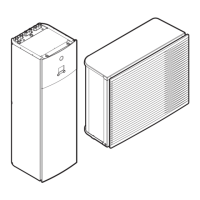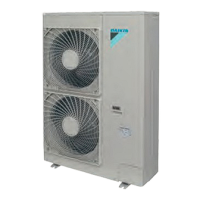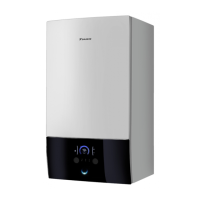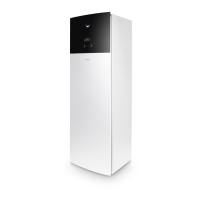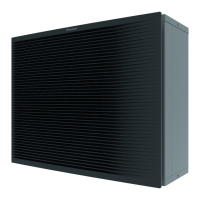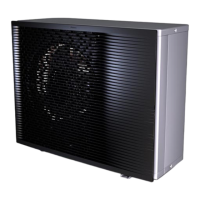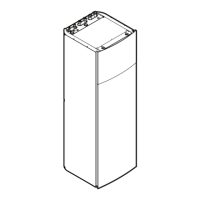7 Installation
Installer reference guide
32
ERLQ004~008CAV3 + EHBH/X04+08CA
Daikin Altherma - Low Temperature Split
4P313774-1C – 2012.11
Piping size
(mm)
Tightening
torque (N•m)
Flare
dimensions
(mm)
Flare shape
(mm)
Ø6.4 15~17 8.7~9.1
Ø15.9 63~75 19.3~19.7
7.4.1 Pipe bending guidelines
Use a pipe bender for bending. All pipe bends should be as gentle
as possible (bending radius should be 30~40 mm or larger).
7.4.2 To flare the pipe end
CAUTION
▪ Incomplete flaring may cause refrigerant gas leakage.
▪ Do NOT re-use flares. Use new flares to prevent for
refrigerant gas leakage.
▪ Use flare nuts that are included with the unit. Using
different flare nuts may cause to refrigerant gas
leakage.
1 Cut the pipe end with a pipe cutter.
2 Remove burrs with the cut surface lacing downward so that the
chips does not enter the pipe.
a Cut exactly at right angles.
b Remove burrs.
3 Remove the flare nut from the stop valve and put the flare nut
on the pipe.
4 Flare the pipe. Set exactly at the position as shown in the
following illustration.
Conventional flare tool
Flare tool for
R410A (clutch
type)
Clutch type
(Ridgid-type)
Wing nut type
(Imperial-type)
A 0~0.5 mm 1.0~1.5 mm 1.5~2.0 mm
5 Check that the flaring is properly made.
a Flare’s inner surface must be flawless.
b The pipe end must be evenly flared in a perfect
circle.
c Make sure the flare nut is lifted.
7.4.3 To braze the pipe end
The indoor unit and outdoor unit have flare connections. Connect
both ends without brazing. If brazing should be needed, take the
following into account:
▪ When brazing, blow through with nitrogen to prevent creation of
large quantities of oxidized film on the inside of the piping. This
film adversely affects valves and compressors in the refrigerating
system and prevents proper operation.
▪ Set the nitrogen pressure to 20 kPa (just enough so it can be felt
on the skin) with a pressure-reducing valve.
a Refrigerant piping
b Part to be brazed
c Taping
d Manual valve
e Pressure-reducing valve
f Nitrogen
▪ Do NOT use anti-oxidants when brazing pipe joints.
▪ Do NOT use flux when brazing copper-to-copper refrigerant
piping. Use phosphor copper brazing filler alloy (BCuP), which
does not require flux.
7.4.4 To handle the stop valve
Take the following guidelines into account:
▪ The stop valves are factory closed.
▪ The following illustration shows each part required in handling the
valve.
a Service port and service port cap
b Valve stem
c Field piping connection
d Stem cap
▪ Keep both stop valves open during operation.
▪ Do NOT apply excessive force to the valve stem. Doing so may
break the valve body.
▪ Always make sure to secure the stop valve with a spanner, then
loosen or tighten the flare nut with a torque wrench. Do NOT place
the spanner on the stem cap, as this could cause a refrigerant
leak.
a Spanner
b Torque wrench
▪ When it is expected that the operating pressure will be low (e.g.
when cooling will be performed while the outside air temperature
is low), sufficiently seal the flare nut in the stop valve on the gas
line with silicon sealant to prevent freezing.
Silicon sealant, make sure there is no gap.
7.4.5 To open/close the stop valve
1 Remove the valve cover
2 Insert a hexagon wrench (liquid side: 4 mm, gas side: 6 mm)
into the valve stem and turn the valve stem:

